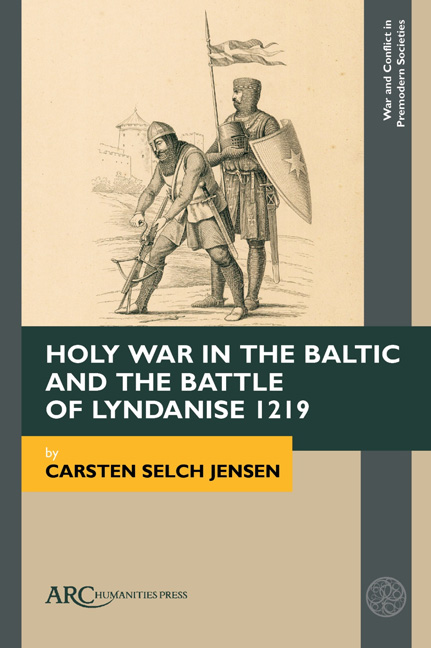Book contents
- Frontmatter
- Contents
- List of Illustrations
- Acknowledgments
- Introduction. Holy War in the Baltic and the Battle of Lyndanise 1219
- Chapter 1 Foreign Shores—Foreign People: The Medieval Baltic and its People
- Chapter 2 Fighting God’s War: Papal Crusading Politics in the Baltic from the Early 1100s until the Early 1200s
- Chapter 3 A Society Organized for War: Denmark at the Beginning of the Thirteenth Century
- Chapter 4 Competing Powers: The German Mission in Livonia and the Initial Quest for Estonia
- Chapter 5 Waging War in the Wilderness: Western Military Traditions Meet Baltic Traditions
- Chapter 6 The Danish Expedition to Estonia in 1219 and the Battle of Lyndanise
- Chapter 7 Conquering Hearts and Minds: The Aftermath of the Battle
- Conclusion A Penny in the Box: How Estonia Came to Save Denmark
- Select Bibliography
- Index
Conclusion - A Penny in the Box: How Estonia Came to Save Denmark
Published online by Cambridge University Press: 08 May 2024
- Frontmatter
- Contents
- List of Illustrations
- Acknowledgments
- Introduction. Holy War in the Baltic and the Battle of Lyndanise 1219
- Chapter 1 Foreign Shores—Foreign People: The Medieval Baltic and its People
- Chapter 2 Fighting God’s War: Papal Crusading Politics in the Baltic from the Early 1100s until the Early 1200s
- Chapter 3 A Society Organized for War: Denmark at the Beginning of the Thirteenth Century
- Chapter 4 Competing Powers: The German Mission in Livonia and the Initial Quest for Estonia
- Chapter 5 Waging War in the Wilderness: Western Military Traditions Meet Baltic Traditions
- Chapter 6 The Danish Expedition to Estonia in 1219 and the Battle of Lyndanise
- Chapter 7 Conquering Hearts and Minds: The Aftermath of the Battle
- Conclusion A Penny in the Box: How Estonia Came to Save Denmark
- Select Bibliography
- Index
Summary
WHILE FOR SOME time the papacy had tried re-establish stronger bonds— perhaps even a renewed union—between the Western and Eastern churches, attempts had not been crowned with any significant success during the thirteenth century. Henry of Livonia bears great witness to the rising conflicts between the Catholic Westerners and the Orthodox Easterners during the conquest of both Livonia and Estonia. Mutual tolerance was replaced by hostility and outright war between the various Rus’ princes and the Germans and Danes in Livonia and Estonia; famous is the battle on Lake Peipus in 1242 with Prince Aleksandr Nevskij (1221–1263) defeating the knightly brethren of the Teutonic Order and their vas-sals. This was only one of many encounters throughout the hundred-year period up to 1346, when the Danish kings finally withdrew from Estonia, a region continually marked by unrest and wars.
The death of King Valdemar II in 1241 meant that the Danish involvement in Esto-nia became somewhat weakened in the years to come. Internal conflicts concerning the succession of the dead king's sons and the various branches of the family made it difficult to pursue a consistent foreign policy in an extremely unruly region that saw the Teutonic Order strive for more power and land. Also decisive were the internal and repeated disputes between archbishops and kings in Denmark, which gained momen-tum under Archbishop Jakob Erlandsen (1254–1274) and reached a critical peak under Archbishop Jens Grand (1289–1302), absorbing (more or less) the full attention of the Danish rulers.
Formally, of course, the Danish kings were present in Estonia even during these critical and turbulent years. There were two important Danish officials in Estonia: a bishop (in contemporary sources referred to as “the bishop of Reval,” Episcopatus Revaliensis) and the king's bailiff. The bishopric formally belonged to the archbish-opric of Lund, but ever since 1219 it had been the Danish kings who appointed the bishops of Reval/Tallinn. In addition, there was the aforementioned bailiff, who was the king's formal deputy, having his seat in the castle on Toompea Hill. Around 1282, a council was set up consisting of twelve of the king's most important vassals in the region.
- Type
- Chapter
- Information
- Holy War in the Baltic and the Battle of Lyndanise 1219 , pp. 133 - 138Publisher: Amsterdam University PressPrint publication year: 2024



